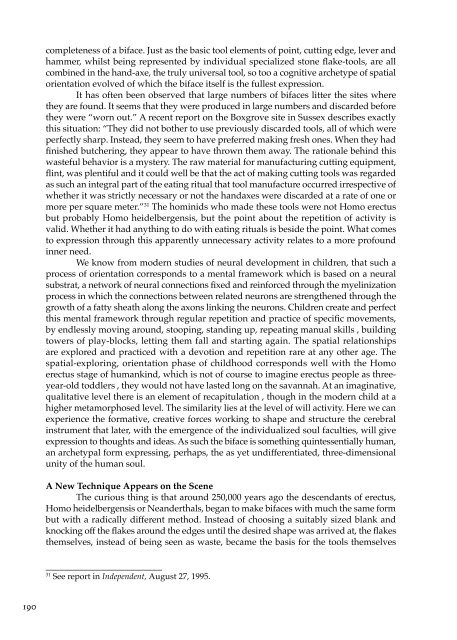The Spirit in Human Evolution - Waldorf Research Institute
The Spirit in Human Evolution - Waldorf Research Institute
The Spirit in Human Evolution - Waldorf Research Institute
Create successful ePaper yourself
Turn your PDF publications into a flip-book with our unique Google optimized e-Paper software.
completeness of a biface. Just as the basic tool elements of po<strong>in</strong>t, cutt<strong>in</strong>g edge, lever and<br />
hammer, whilst be<strong>in</strong>g represented by <strong>in</strong>dividual specialized stone flake-tools, are all<br />
comb<strong>in</strong>ed <strong>in</strong> the hand-axe, the truly universal tool, so too a cognitive archetype of spatial<br />
orientation evolved of which the biface itself is the fullest expression.<br />
It has often been observed that large numbers of bifaces litter the sites where<br />
they are found. It seems that they were produced <strong>in</strong> large numbers and discarded before<br />
they were “worn out.” A recent report on the Boxgrove site <strong>in</strong> Sussex describes exactly<br />
this situation: “<strong>The</strong>y did not bother to use previously discarded tools, all of which were<br />
perfectly sharp. Instead, they seem to have preferred mak<strong>in</strong>g fresh ones. When they had<br />
f<strong>in</strong>ished butcher<strong>in</strong>g, they appear to have thrown them away. <strong>The</strong> rationale beh<strong>in</strong>d this<br />
wasteful behavior is a mystery. <strong>The</strong> raw material for manufactur<strong>in</strong>g cutt<strong>in</strong>g equipment,<br />
fl<strong>in</strong>t, was plentiful and it could well be that the act of mak<strong>in</strong>g cutt<strong>in</strong>g tools was regarded<br />
as such an <strong>in</strong>tegral part of the eat<strong>in</strong>g ritual that tool manufacture occurred irrespective of<br />
whether it was strictly necessary or not the handaxes were discarded at a rate of one or<br />
more per square meter.” 31 <strong>The</strong> hom<strong>in</strong>ids who made these tools were not Homo erectus<br />
but probably Homo heidelbergensis, but the po<strong>in</strong>t about the repetition of activity is<br />
valid. Whether it had anyth<strong>in</strong>g to do with eat<strong>in</strong>g rituals is beside the po<strong>in</strong>t. What comes<br />
to expression through this apparently unnecessary activity relates to a more profound<br />
<strong>in</strong>ner need.<br />
We know from modern studies of neural development <strong>in</strong> children, that such a<br />
process of orientation corresponds to a mental framework which is based on a neural<br />
substrat, a network of neural connections fixed and re<strong>in</strong>forced through the myel<strong>in</strong>ization<br />
process <strong>in</strong> which the connections between related neurons are strengthened through the<br />
growth of a fatty sheath along the axons l<strong>in</strong>k<strong>in</strong>g the neurons. Children create and perfect<br />
this mental framework through regular repetition and practice of specific movements,<br />
by endlessly mov<strong>in</strong>g around, stoop<strong>in</strong>g, stand<strong>in</strong>g up, repeat<strong>in</strong>g manual skills , build<strong>in</strong>g<br />
towers of play-blocks, lett<strong>in</strong>g them fall and start<strong>in</strong>g aga<strong>in</strong>. <strong>The</strong> spatial relationships<br />
are explored and practiced with a devotion and repetition rare at any other age. <strong>The</strong><br />
spatial-explor<strong>in</strong>g, orientation phase of childhood corresponds well with the Homo<br />
erectus stage of humank<strong>in</strong>d, which is not of course to imag<strong>in</strong>e erectus people as threeyear-old<br />
toddlers , they would not have lasted long on the savannah. At an imag<strong>in</strong>ative,<br />
qualitative level there is an element of recapitulation , though <strong>in</strong> the modern child at a<br />
higher metamorphosed level. <strong>The</strong> similarity lies at the level of will activity. Here we can<br />
experience the formative, creative forces work<strong>in</strong>g to shape and structure the cerebral<br />
<strong>in</strong>strument that later, with the emergence of the <strong>in</strong>dividualized soul faculties, will give<br />
expression to thoughts and ideas. As such the biface is someth<strong>in</strong>g qu<strong>in</strong>tessentially human,<br />
an archetypal form express<strong>in</strong>g, perhaps, the as yet undifferentiated, three-dimensional<br />
unity of the human soul.<br />
A New Technique Appears on the Scene<br />
<strong>The</strong> curious th<strong>in</strong>g is that around 250,000 years ago the descendants of erectus,<br />
Homo heidelbergensis or Neanderthals, began to make bifaces with much the same form<br />
but with a radically different method. Instead of choos<strong>in</strong>g a suitably sized blank and<br />
knock<strong>in</strong>g off the flakes around the edges until the desired shape was arrived at, the flakes<br />
themselves, <strong>in</strong>stead of be<strong>in</strong>g seen as waste, became the basis for the tools themselves<br />
_________________________<br />
31<br />
See report <strong>in</strong> Independent, August 27, 1995.<br />
190
















